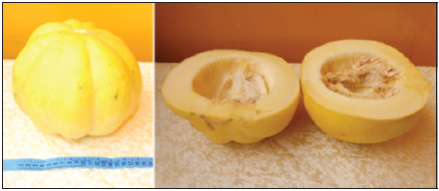INTRODUCTION
The genus Cucumis, which includes melon (Cucumis melo L.), has numerous wild species in Africa, which is its origin (Sebastian et al., 2010), from where it dispersed to the rest of the world, and, nowadays, it is cultivated under tropical and subtropical climatic conditions (Reddy et al., 2013a). According to the FAO (2014), melons and watermelons, from the com mercial point of view, are horticultural crops because they are temporary crops.
In 2010, 1,074,558 ha of melon were grown world wide. Production in that year reached 25.0 million metric tons, with China being the largest producer, accounting for 45% of global production (Monge-Pérez, 2013). The data published by FAOSTAT, the statistical agency of the Food and Agriculture Organi zation of the United Nations (FAO), for 2014 indicat ed that global melon production was 29.62633 billion tons, over an area of 1,189,565 ha, with an average yield of 2.49 kg m2. The data from (FAO, 2018), based on the imputation methodology, indicated that, in Ecuador, 2,036 ha were cultivated in 2016, with an average yield of 2.43 kg m2, which represented a total production of 49,201 t. The cultivated area had a high percentage of hybrid melon seeds from transnational companies.
On the Ecuadorian coast, there are creole melons, grown by small farmers, which are highly appreciat ed by local consumers because of their aroma and fla vor. The Ecuadorian creole melon is a little explored cultivar. This melon exhibits a wide phenotypic di versity for fruit traits, including fruit ripening, fruit shape, size, flesh color, texture, sweetness and aroma (Latrasse et al., 2017). Preliminary tests showed that the yields of these creole varieties were below 4 t ha, much lower than the production of imported hybrids that are commercially cultivated. This is possibly due to the poor quality of the creole variety seeds, which are obtained from the previous harvest or purchased in the local market (UPOV, 2008).
In the provinces of Manabí, Los Ríos and Guayas, creole melon crops have been identified, within which there is the melon known as 'Slice Melon' (Fig. 1), which is characterized by having a large fruit that can reach weigh more than 4 kg, with a rounded, oval or flattened shape, thick, smooth bark and segmentations or grooves arranged as meridians (apostille), pale yellow to intense yellow color, and white, pink or orange broad pulp, with a characteris tic fragrant odor and sweet flavor, possibly belonging to C. melo var. Naud cantaloupensis, which, accord ing to (Guis et al., 1998), have fruits with a round shape, medium size, smooth surface, marked ribs, orange flesh, aromatic and sweet flavor. The intra-specific classification of C. melo has been reviewed several times, the most recent performed by Pitrat, in 2008, included within this species are two subspecies, melo and agrestis and 15 varieties: Cantalupensis and inodorus varieties have greater commercial interest (Pavan et al., 2017) and are the most cultivated in the world (Abraham et al., 2018).
The use of creole melon varieties depends on the avail ability of seeds and access for farmers to other pro duction resources such as land, water, fertilizers and work capacity (Chacón and García, 2016). To main tain and improve the competitiveness of the creole melon, it is necessary to promote innovation in variet ies and crop management technologies. New varietal options that offer better productive and organoleptic characteristics must be sought (Monge-Pérez, 2013). Previous research showed the productive potential of the creole melon, which creates the need to identify the ability to achieve advances in the production and organoleptic quality of the sliced melons with a for mal procedure. The aim of this research was to evalu ate 20 half-sib families of slice creole melon (Cucumis melo L.) on the Ecuadorian coast with characteristics of production and quality of the fruits.
MATERIALS AND METHODS
This study was conducted in Palenque, Provincia de Los Ríos, Ecuador, located at latitude -638455 and longitude -9841885. The main climate characteristics are presented in (Tab. 1).
Table 1 Climatological characteristics in Palenque, Provincia de Los Ríos, Ecuador. 2018.
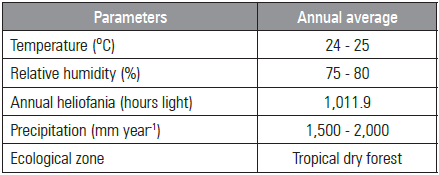
Source: GADCQ (2014), INAMHI (2016).
From a massal population that represented the cre ole melon collection, made between August 2015 and April 2016, on the Ecuadorian coast, 20 half-sib families were selected for further evaluation. Seeds from the massal population were used as a control treatment.
The 20 half-sib families and the control treatment were evaluated in a randomized complete block de sign with three repetitions. In each repetition, the families were located randomly. The experiment units were linear plots with 5 plants, the net plot had 3 plants, with 3 m between rows and 1.50 m between plants, according to the traditional form of cultiva tion of creole melons; and the population density was 2,222 plants/ha.
In each plant, characteristics related to the com mercial fruit were evaluated: fruit weight (FW) us ing an electronic scale Jadever JWP with a capacity of 6,000.0±0.1 g, fruit diameter (FD), fruit length (FL), pulp thickness (PT) (Wang et al., 2016), bark thickness (BT) and fruit cavity (FC) (Aragão et al., 2015) measured with a digital electronic caliper brand Uberman, pulp firmness (PF) quantified with a fruit hardness meter model FHT-804 with a capacity of 24±0.1 kg cm-2 (Monge, 2016), (SS) soluble solids (°Brix) measured with a RHB-50ATC refractometer, scale of 0.0-50.0±0.2% (Aragão et al., 2015), pulp acidity (PA) quantified with a digital pH electronic meter Biocharge ATC and production per hectare cal culated with the average weight of the fruits in the population density of 2,222 plants/ha.
Each characteristic was submitted to an analysis of variance under the experiment block design, random ly with three repetitions. In the case of significant differences between the families, the comparison of means was made with the Tukey test (P≤0.05) (Abra ham et al., 2018). A correlation analysis was carried out for the evaluated characteristics. The results were processed with the statistical software SAS 9.4.
The environmental (1), genetic (2) and phenotypic (3) variances were determined using the analysis of variance, according to the equations below:
where CMf is mean square of the families, CMe is mean square of the experimental error, and r is num ber of repetitions (Pistorale et al., 2008).
The coefficients of genetic (4) and environmental (5) variation were calculated according to:
Genetic variation coefficient
Environmental variation coefficient
Broad heritability (6) for each variable was estimated classically, as described below:
Generic progress expected with the classic formula: Δg = ds x h2 A, where ds = differential of selection.
The values of the phenotypic variation coefficients (PVC), genotypic variation (GVC) and genetic prog ress were low (<10%), moderate (10-20%) and high (>20%). The heritability values were low (<30%), moderate (30-60%) and high (>60%), as used by (Reddy et al., 2013a).
The establishment of the plots was done with di rect sowing, depositing a seed previously treated with aluminum tris-o-ethylphosphonato per site. The crop received fertilization at 150 kg ha-1 of the formula 8-20-20 plus 100 kg ha-1 of urea N at 46%, with two applications. Pre-emergence weed control was carried out with an application of glyphosate, along with a post-emergence application of para quat dichloride 276 g L-1 between the plants and an application of haloxyfop-R-methyl ester, 108 g. Ad ditionally, two manual cleansings were performed. The pest control, mainly trips (Frankliniella occidentalis) and aphids (Aphididae), was carried out with six rotating applications of abamectin, imidacloprid and triflumuron. The control of fungal diseases was carried out in a preventive manner with eight rotat ing applications of fosetil aluminum and fludioxonil 2.5 g + metalaxil-M 1.0 g. The soil remained at field capacity with a drip irrigation system installed with drippers that supplied water at a rate of 2 L h-1. Fruit harvesting began 93 d after sowing, when the fruits had the characteristic yellow color of maturity.
RESULTS AND DISCUSSION
The mean squares of the 10 characteristics evaluated in the 20 half-sib families of creole melon (Tab. 2) pre sented statistically significant differences (P≤0.05) for fruit cavity (FC) and highly statistically signifi cant (P≤0.01) differences for the other nine charac teristics, showing high variability between the melon families. The coefficient of variation (CV) was higher than 30% for fruit weight (FW), pulp firmness (PF) and production; the other evaluated characteristics had a (CV) less than 23%. These results indicated that the creole melon massal population contained broad reserves of genetic variation and adaptation to different environmental conditions (Eguiarte et al., 2013), in agreement with the results obtained by Reddy et al. (2013a), who stated that the highly sig nificant differences between the genotypes indicated the presence of a sufficient amount of variability in the germplasm, facilitating selection possibilities for modifying the studied characteristics.
Table 2 Mean squares of the analysis of variance and coefficients of variation for the 10 fruit characteristics of the creole melon (Cucumis melo L.) cantaloupe. Palenque, Provincia de Los Ríos, Ecuador. 2018.

FW, fruit weight; FD, fruit diameter; FL, fruit length; PT, pulp thickness; BT, bark thickness; FC, fruit cavity; PF, pulp firmness; PA, pulp acidity; SS, soluble solids (°Brix); P production (kg ha-1). DF, degrees of freedom; ** significance level P≤0.01; "significance level P≤0.05 of probability; NS: non-significant.
The averages, maximum, and minimum values pre sented significant difference for the characteristics of the 20 melon half-sib families (Tab. 3). Family 93 showed the highest average fruit weight (5,201.80 g), fruit diameter (179.59 mm) and production (11,560.00 kg ha-1), family 176 showed the highest average for fruit length (213.78 mm), family 117 did so for the thickness of the pulp (38.62 mm), family 21 did so for the thickness of the bark (1.07 mm), family 68 did so for fruit cavity (103.60 mm), family 47 did so for pulp firmness (5.11), (the minimum ac ceptable firmness is 3.1 kg cm2 for Cantaloupe melon and Orange Flesh (Monge, 2016)), family 123 did so for acidity of pulp (7.04) and family 196 (8.44) did so for soluble solids. These values were higher than those reported by (Reddy et al., 2013a) in his research on 35 lines of cantaloupe cross-linked melon, who ob tained an average fruit weight of (g) 416.57±17.94, fruit diameter of (cm) 8.56±0.38, fruit length of (cm) 10.70±0.48, pulp thickness of (cm) 1.58±0.11, bark thickness of (mm) 1.70±0.14, fruit cavity length of (cm) 6.26±0.33, fruit cavity width of (cm) 4.65±0.25, total soluble solids of (°Brix) 6.70±0.15 and fruit production of (kg/plant) 1.16±0.15. Monge (2016) evaluated 70 greenhouse melon genotypes and found inferior results for fruit weight and pulp firm ness and higher results for percentage of total soluble solids; in addition, the characteristics showed wide variability among the genotypes in terms of average fruit weight (268.7-1279.4 g), production per area (0 70.85 t ha-1), fruit firmness (0.5-4.8 kg cm-2) and per centage of total soluble solids (9.9-17.1°Brix).
Table 3 Averages, maximum values, minimum values and significant minimum difference for the characteristics of 20 half-sib families of creole melon (Cucumis melo L.) cantaloupe. Palenque, Provincia de Los Ríos, Ecuador. 2018.
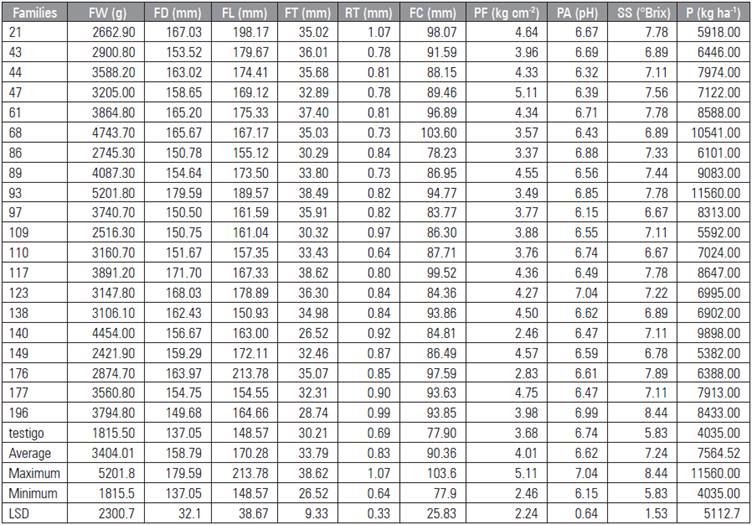
FW, fruit weight; FD, fruit diameter; FL, fruit length; PT, pulp thickness; RT, rind thickness; FC, fruit cavity; PF, pulp firmness; PA, pulp acidity; SS, soluble solids (°Brix); P production (kg ha-1). LSD = Least significant difference Tukey (P≤0.05).
The correlation coefficients between the character istics in the 20-half-sib-families of melon (Tab. 4) showed positive significant phenotypic associations between the fruit weight (FW) with the fruit diam eter (FD), fruit length (FL), pulp thickness (PT), fruit cavity (FC), soluble solids (SS, °Brix) and production (kg ha-1), indicating that the selection for a greater fruit weight would lead to an increase in the thick ness of the pulp, soluble solids and production per hectare. A negative, non-significant correlation was found between the fruit weight (FW) and the rind thickness (RT), pulp acidity (PA) and pulp firmness (PF). There were significant and positive phenotypic correlations between the (SS) soluble solids (°Brix) and the fruit diameter (FD), fruit length (FL), pulp thickness (PT), fruit cavity (FC) and production (kg ha-1). All significant correlations were positive except for the correlation between the pulp acidity (PA) and the pulp firmness (PF) and production (kg ha-1). The correlation can be attributed to the presence of pleiotropic effects of the genes, physiological relationship and development, environmental effect or a com bination of all the above (Reddy et al., 2013b). The correlation coefficient associations, of great or little value, could be found for an improvement program through selection.
Table 4 Correlation coefficients (r) among the characteristics evaluated in 20 half-sib families of creole melon (Cucumis melo L.) cantaloupe. Palenque, Provincia de Los Ríos, Ecuador. 2018.
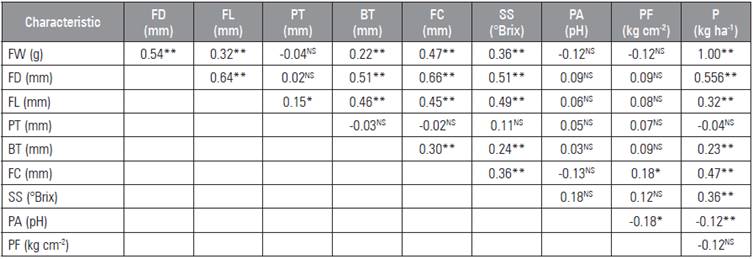
FW, fruit weight; FD, fruit diameter; FL, fruit length; PT, pulp thickness; BT, bark thickness; FC, fruit cavity; SS, soluble solids; PA, pulp acidity; PF, pulp firmness; P, production.
** significance level P≤0.01; * significance level P≤0.05 of probability; NS: non-significant.
The values of the coefficients of genotypic variation (GVC) for the characteristics evaluated in the 20 half-sib families, in general, were lower than the values of the coefficients of environmental variation (EVC). The parameters of heritability (h2 A) were moderate, and the genetic advance (Δg) had a low magnitude (Tab. 5).
Table 5 Averages, genetic variation coefficient, environmental variation coefficient, heritability in a broad sense and expected genetic progress (expressed in percentage) of the characteristics evaluated in 20 half-sib families of creole melon (Cucumis melo L.) cantaloupe. Palenque, Provincia de Los Ríos, Ecuador. 2018.
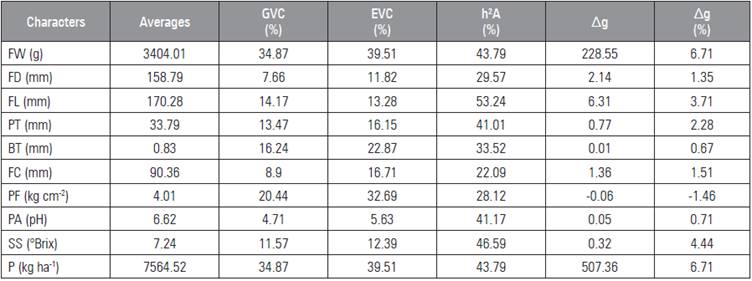
GVC, genetic variation coefficient; EVC, environmental variation coefficient; h2 A heritability in a broad sense, Δg, expected genetic progress; FD, fruit diameter; FL, fruit length; CT, cortex thickness; PT, pulp thickness; FC, fruit cavity; SS, soluble solids; PA, pulp acidity; PF, pulp firmness; P, production (kg ha-1).
For the fruit weight (FW), the (GVC) was 34.87%, and the (EVC) was 39.51%, indicating that both the genetic and environmental components had similar variations in the phenotypic manifestation of the characteristic. These results differ with that reported by Reddy et al. (2013b), who stated that the aver age fruit weight registered high EVC and GVC val ues, which indicated the presence of a high degree of variability and a better scope for the improvement of these characteristics through selection. The soluble solids (SS) presented a GVC equal to 11.57% and a EVC equal to 12.39%, indicating little genetic and en vironmental variation in the expression of this char acteristic. Reddy et al. (2013b) reported that the total soluble solids showed low to moderate EVC and GVC values, which indicated the presence of a high degree of variability and, therefore, a greater margin of se lection. The production (kg ha-1) presented a GVC of 34.87% and a EVC of 39.50%, indicating similar variations in the manifestation of this characteristic.
The wide-ranging heritability estimates had a moder ate magnitude (30-60%) for all the evaluated charac teristics, except for fruit diameter (FD), fruit cavity (FC) and pulp firmness (PF), which had a low magni tude (<30%), indicating that environmental variance plays an important role in the manifestation of the phenotypic variance of the evaluated characteristics. These estimates differ from those found by Reddy et al. (2013b), who reported high heritability values for fruit length (83.92%), average fruit weight (90.35%), length of fruit cavity (89.41%), width of the fruit cavity (66.93%), bark thickness (70.39%) and total soluble solids (86.51%). Rakhi and Rajamony (2005) reported high heritability for fruit length, fruit cir cumference, average fruit weight, and production per plant, which meant that the variability of these characteristics had a high percentage because of ge netic variation with greater correspondence between the phenotypes and the genotype. Reddy et al. (2013) found high heritability for the production in melon, which implied that this characteristic can be im proved through selection.
The estimated values of genetic progress had a low magnitude (<10%) in all the evaluated character istics because of the moderate or low heritability. Reddy et al. (2013) reported different genetic prog ress for all the characteristics, with the exception of fruit weight and length. The estimates of genetic ad vance had a high great magnitude (> 20%) for aver age fruit weight (57.27%), bark thickness (49.04%), total soluble solids (24.68%), and fruit production (30.50%) and a moderate magnitude (10-20%) for the fruit length (17.21%), fruit diameter (10.02%) and pulp thickness (13.51%).
Although the heritability was moderate for fruit weight (FW), soluble solids (SS) and production (kg ha-1), the genetic advance was significant taking into account the agronomic and economic importance of these characteristics (Rakhi and Rajamony, 2005). In general, selection for melon types with high produc tion and quality should focus on average fruit weight, production per hectare and content of soluble solids.
CONCLUSIONS
Moderate genetic variability was found in all the characteristics evaluated in the 20 half-sib families of the creole melon; therefore, there are possibilities for improving these characteristics through recurrent se lection. All the families were superior to the control treatment in 7 of the 10 fruit characteristics. Family 93 stood out for fruit weight and production (kg ha-1), and family 196 did so for total soluble solids. Heritability broadly had a moderate magnitude for all the analyzed characteristics. The genetic progress had a low magnitude for most characteristics. In recurrent selection processes, the characteristics demanded by the market, mainly soluble solids and average fruit weight, must be considered.













